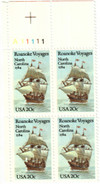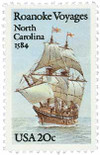
# 2093 - 1984 20c Roanoke Voyages
U.S. #2093
1984 20¢ Roanoke Voyages
- Issued on the 400th anniversary of the arrival of the first of three Roanoke voyages in present-day North Carolina
Stamp Category: Commemorative
Value: 20¢, rate for first-class mail
First Day of Issue: July 13, 1984
First Day City: Manteo, North Carolina
Quantity Issued: 120,000,000
Printed by: American Bank Note Company
Printing Method: Photogravure
Format: Panes of 50 in sheets of 200
Perforations: 11
Why the stamp was issued: To mark the 400th anniversary of the Roanoke voyages to the New World.
About the stamp design: Renowned maritime artist Charles Lundgren provided the art for this stamp. His painting pictures the Elizabeth, the ship used in the Roanoke voyages. There were no drawings or plans from which he could draw reference. Lundgren could only work from descriptions written about the 1585 voyage.
First Day City: This stamp was issued in Manteo, North Carolina, a town named for a Roanoke Indian chief. Manteo had previously been the first day city for the 1937 Virginia Dare stamp (#796). Dare was the first English child born in the New World, her parents having arrived on the third Roanoke voyage.
History the stamp represents: On July 13, 1584, the first of three Roanoke voyages arrived in present-day North Carolina.
Sir Walter Raleigh, who had quickly earned the favor of Queen Elizabeth I, funded the voyages. On March 25, 1584, the queen issued Raleigh a royal charter to “discover, search, find out, and view such remote heathen and barbarous Lands, Countries, and territories … to have, hold, occupy, and enjoy” in exchange for one-fifth of all the gold and silver mined there. The charter also stated that Raleigh must establish a settlement within seven years or lose the right to do so.
Raleigh didn’t personally lead any of his expeditions, but he funded and authorized them. The first expedition, under the command of Philip Amada and Arthur Barlowe, departed England on April 27, 1584. Less than three months later it arrived on the coast of North Carolina on July 13. Upon their landing, they were the first people to wave the English flag above the New World’s shores.
The British colonists attempted to establish friendly relations with the Native Americans but were unsuccessful. They also didn’t have enough supplies to set up a permanent settlement, so they returned to England. Raleigh was then knighted for the expedition that claimed the land in the name of the queen, though he never sailed on any of the voyages.
A second voyage departed England in 1585. Its members returned in 1586 due to food shortages and hostile Indians. The third voyage brought 91 men, 17 women, and nine children to Roanoke Island in 1587.
Among those that made the voyage were Governor John White, his daughter Eleanor, and her husband Ananias Dare. Pregnant during the journey, Eleanor gave birth to a baby girl on August 18, and named her Virginia. She was the first of two children known to be born in the colony.
As the colonists struggled to establish their homes, they begged Governor White to return to England for supplies. He reluctantly left on August 27, and planned to return in one year. However, England’s war with Spain delayed White’s trip back by three years. By the time he returned to Roanoke, all of the colonists had disappeared from the area.
Some buildings were collapsed and others were taken down, which led White to believe they didn’t leave in a hurry. Before he left, White instructed the colonists to carve a Maltese cross on a nearby tree if they had to leave by force. Since he didn’t find one, he believed they left of their own will. The only clues they left behind were the word “Croatoan” carved on a post and “Cro” on a nearby tree. White took this to mean that they had relocated to the Croatoan Island (present-day Hatteras Island) but he was never able to search there. Some historians believe the colonists may have joined American Indian tribes living in the region, but have never been able to confirm this.
U.S. #2093
1984 20¢ Roanoke Voyages
- Issued on the 400th anniversary of the arrival of the first of three Roanoke voyages in present-day North Carolina
Stamp Category: Commemorative
Value: 20¢, rate for first-class mail
First Day of Issue: July 13, 1984
First Day City: Manteo, North Carolina
Quantity Issued: 120,000,000
Printed by: American Bank Note Company
Printing Method: Photogravure
Format: Panes of 50 in sheets of 200
Perforations: 11
Why the stamp was issued: To mark the 400th anniversary of the Roanoke voyages to the New World.
About the stamp design: Renowned maritime artist Charles Lundgren provided the art for this stamp. His painting pictures the Elizabeth, the ship used in the Roanoke voyages. There were no drawings or plans from which he could draw reference. Lundgren could only work from descriptions written about the 1585 voyage.
First Day City: This stamp was issued in Manteo, North Carolina, a town named for a Roanoke Indian chief. Manteo had previously been the first day city for the 1937 Virginia Dare stamp (#796). Dare was the first English child born in the New World, her parents having arrived on the third Roanoke voyage.
History the stamp represents: On July 13, 1584, the first of three Roanoke voyages arrived in present-day North Carolina.
Sir Walter Raleigh, who had quickly earned the favor of Queen Elizabeth I, funded the voyages. On March 25, 1584, the queen issued Raleigh a royal charter to “discover, search, find out, and view such remote heathen and barbarous Lands, Countries, and territories … to have, hold, occupy, and enjoy” in exchange for one-fifth of all the gold and silver mined there. The charter also stated that Raleigh must establish a settlement within seven years or lose the right to do so.
Raleigh didn’t personally lead any of his expeditions, but he funded and authorized them. The first expedition, under the command of Philip Amada and Arthur Barlowe, departed England on April 27, 1584. Less than three months later it arrived on the coast of North Carolina on July 13. Upon their landing, they were the first people to wave the English flag above the New World’s shores.
The British colonists attempted to establish friendly relations with the Native Americans but were unsuccessful. They also didn’t have enough supplies to set up a permanent settlement, so they returned to England. Raleigh was then knighted for the expedition that claimed the land in the name of the queen, though he never sailed on any of the voyages.
A second voyage departed England in 1585. Its members returned in 1586 due to food shortages and hostile Indians. The third voyage brought 91 men, 17 women, and nine children to Roanoke Island in 1587.
Among those that made the voyage were Governor John White, his daughter Eleanor, and her husband Ananias Dare. Pregnant during the journey, Eleanor gave birth to a baby girl on August 18, and named her Virginia. She was the first of two children known to be born in the colony.
As the colonists struggled to establish their homes, they begged Governor White to return to England for supplies. He reluctantly left on August 27, and planned to return in one year. However, England’s war with Spain delayed White’s trip back by three years. By the time he returned to Roanoke, all of the colonists had disappeared from the area.
Some buildings were collapsed and others were taken down, which led White to believe they didn’t leave in a hurry. Before he left, White instructed the colonists to carve a Maltese cross on a nearby tree if they had to leave by force. Since he didn’t find one, he believed they left of their own will. The only clues they left behind were the word “Croatoan” carved on a post and “Cro” on a nearby tree. White took this to mean that they had relocated to the Croatoan Island (present-day Hatteras Island) but he was never able to search there. Some historians believe the colonists may have joined American Indian tribes living in the region, but have never been able to confirm this.









